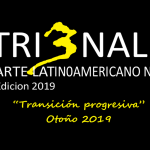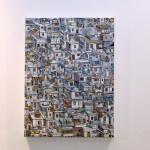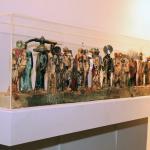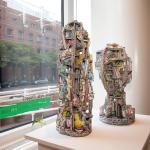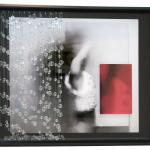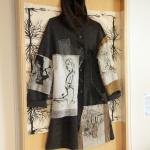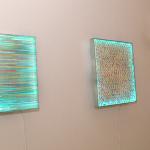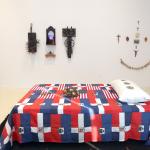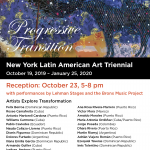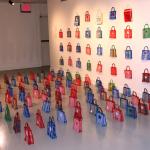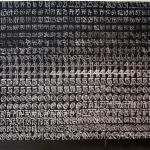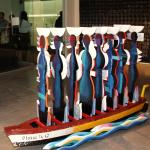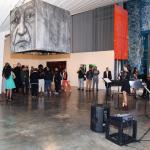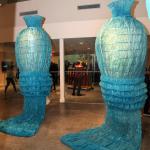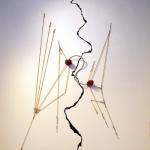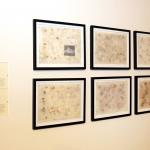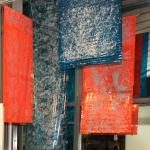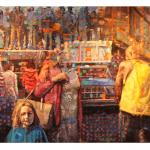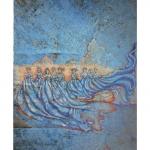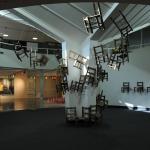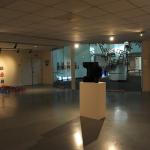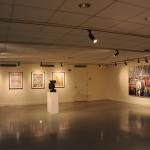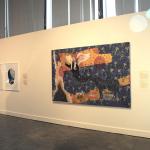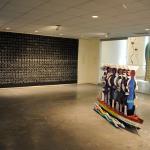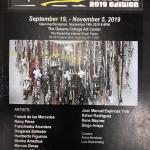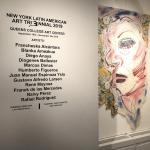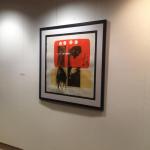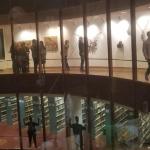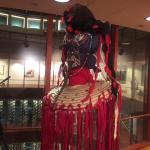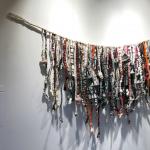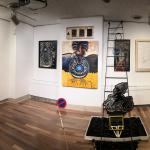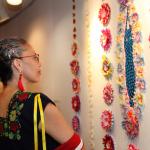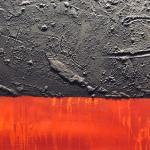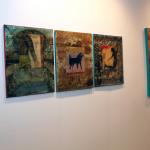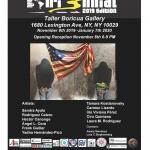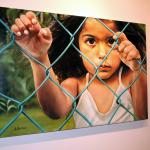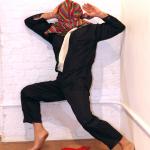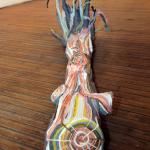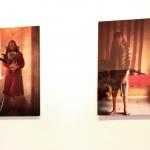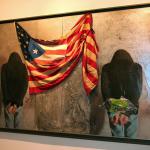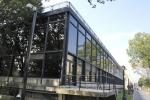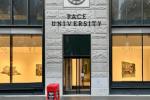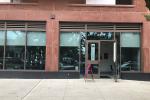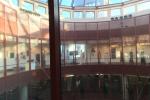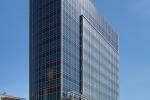Topic: Progressive Transition
The Latin American Art Triennial of New York, 2019 edition, in terms of its curatorial aim, explores transition as the action and effect of moving from one state to another. The Progressive Transition, the established theme, has overflowed its denotation to become, in a definite sense, an exercise that drives transformation in the arts and culture milieu and among its practitioners. One important factor that we propose to explore is the artists’ need to “feel part of something” that can likewise be recognized and defined by others. The exposition events that comprise the Latin American Art Triennial of New York present the theme of the Progressive Transition from a new and specific point of view, which does not seek to prescribe a practice, rather to situate itself within the context and its broad repercussions. The art chosen for the 2019 edition represents the artist operating within the conceptual landscape of a general transition, appraised as a progressive expression, one of artistic-historic linkages, at the personal or collective level.
In recent years the arts management world has shown a marked overall tendency when discussing Latin American Art, choosing to refer to it as Art from Latin America. This is an emerging convention that seeks to highlight, at the semantic level, its rejection of the roundabout, comprehensive construction of a Latin American imaginarium. We are currently going through a phase in which, whether we like it or not, a new delimitation terminology will be proposed. It’s necessary, then, particularly for an artist, to interact with that process and contextualize it as of his/her own identity experience. Latin American art has begun to be valued independently of its sobriquets. Still, at the functional level, the transcendence of memory and history allow for substantial changes. In a globalized setting where all of us are immigrants, we understand the particular need for affirmation as a group in search of healing with regards to the spaces left behind. As a phenomenon, the transition moves forward within the framework of regional or gender reference at the personal level. In creative practice, the critical sense of the changes is subject to the formulation of the proposal. Just as muralism in Mexico marks a reflection of social/national content, the new cultures engaged in permanent class struggle merit a sum of identities. Evidence of this lies in new terms used in the US such as Newyorican, Chicano, Dominica-ish or Latinx. The impact of these terms, in the cultural artistic sense, reaffirms heritage transcended in grammatical contradiction, supported magically in a neologism that seeks to reconcile the broad remembrance of what one is and the inexhaustible quest to reaffirm a permanent presence in the ethnic, racial, reflective and gender semantics sense as well as sociopolitical condition. At this time the topic at hand is becoming the object of conversations and discussions in certain US academic circles.
The curator’s committee focus is based on a hypothetical method that supports the transformation of the collective. Each work of art answers questions about itself in relation to the other works. Formerly, it was said that art was like theoretical physics, tautology, a specialized field with a reduced audience. We wish to create a more diverse audience, a specific, diverse audience. Our perspective represents a Transition in and of itself, which responds to relevant cultural processes within the context of a highly polarized millennium.
Today more than at any other time in human history, a challenging, stark contrast exists between human beings. There is a perception of more and broader variety both culturally and racially. This allows the complexity of new lifestyles to go on display. The inability to continue relying on traditional identities encourages a pronounced interest, which reveals itself in the quest for labels to identify a different notion of what we are. Latin America yearns for a different manner of representation. The inadequacy of the migratory present is characterized by difficulty in recognizing other modes of hybrid culture. This doesn’t mean that these notions have no use in the analysis of postcolonial culture, inasmuch as the hybridization processes were particularly important in its formation over the course of an extended phase of differentiations. No other region of the world exists in which such a rich, diverse cultural and racial mix has occurred.
This despite the fact that all notions of miscegenation are based on a synthesis that tends to erase imbalances and conflicts, or worse yet, that may be used to create a mask that projects the image of a fair, harmonious melding, as is the case with religious syncretism. Its differences and contradictions coexist within the notion of an integrated nation in which all participate. Certain countries such as Mexico, Cuba and Puerto Rico offer examples in which many artists are aware of the vital and the non-existent. They preserve artistic authenticity beyond what they themselves need to express. This critical consciousness is essential in order to disseminate an ideal visual universe that enriches today’s cultural heritage. In this sense, the creative worker seeks to challenge and/or influence sensitive/receptive audiences, whereas in the Progressive Transition, artists, in their attempt to push the limits, question the premises that have long underpinned Eurocentric art. The artists represented in this 2019 edition belong to a variety of different generations. They communicate their ideas and beliefs through their work. The participants have found motivation as regards notions of immigration, religion, social justice, history and environmental awareness-raising, as well as in the attempt to redefine the foundations of art, examining problems relevant to them in broad terms. It’s important to underscore again that contemporary Latin American art has historically involved itself in sociopolitical and economic subject matter.
The flexibility of contemporary Latin American Art as a term is no longer capable of encompassing all that it comprises in its totality. A growing number of artists seeks to differentiate their art in radical fashion. The complexity is based on definitions created by exclusionary groups, such as auction houses and the new instances for art appreciation that seek dialogue about a generalization that always finds its framework in a set of subjective factors, which by necessity do not include all those who work and don’t wish to be pigeonholed. Latin American art benefits from the recent increase in the number of artists who live and work all over the world. They circulate internationally and influence upcoming generations, making inter-contextual communication possible while indirectly consolidating pre-established structures. The constant, active reinvention of Contemporary Art and its worldwide presence through the multitude which operates as of its various circumstances implies, not only a transition in the arts, rather their transformation, with divergence as the starting point, ending in the convergent as the search for meaningful art. At present, artists participate in an international artistic terrain the dynamism of which expands their capacity. The changes decreed regarding the aforementioned paradigms, given that these presented a specifically Latin American art from the outset. Some of the artists, who have only recently come to the fore, have divorced themselves from the marriage between art and nationality or art and regional identity. This doesn’t mean that there is no Latin American consciousness based on autonomous concepts that cannot be identified concretely as characteristics that represent a single culture or country. The key distinction lies in the fact that we share a language. The idea of identity begins to manifest itself in the 19th century, in the identity-culture-based idea of Arielism, its characteristics in artistic practice: the use of identifiable elements such as folklore, religious rites, natural environment and even their own history.
For many years Latin American artists have concerned themselves with borders and how to transcend them. This concern also encompassed how identities are shaped, how they add value to themselves by their own efforts and how they transform through their own limitations, in which most borders are shifting and even vanishing, thus creating new barriers. Within the experiences of the subjective, whether in the physical world or the world of information technology, the work of the contemporary artist does not speak from any specific place, rather from its transitory condition. It’s context, therefore, cannot be a place or a country, but the history of referential memory.
As of the seventies, the idea that a break in uniformity has resulted in a favoring of differences and pluralities has become marked in contemporary society. Paradoxically, Contemporary Latin American Art does not face pessimist self-criticism, given that the primacy of adversity must be accompanied by an optimist outlook. Artists have managed to advance beyond all expectation. At the same time, the dialogue established in this edition of the Latin American Art Triennial of New York is a living example of the Progressive Transition, which perforce encompasses a range of generations in the creative field and in turn has shape-shifted to become part of art in the full process of building its own history.
Footnotes:
Freedberg, D.( 1991) El poder de las imágenes: estudios en la historia y teoría de la respuesta. University of Chicago Press, USA.
Alexis Mendoza. América Latina, la cultura y el hombre nuevo, pp. 11-112-23. Wasteland Press, 2006.
Gerardo Mosquera, “El arte latinoamericano deja de serlo,” ARCO Latino, Madrid, 1996, pp 7-10.
Frederico Morais, Las artes plásticas en la América Latina: del trance a lo transitorio, Casa de las Américas, Havana, [1979] 1990, pp 4-5.
Olu Oguibe, “En el corazón de la oscuridad”, Third edition, no. 23, summer 1993, pp 3-8
V. Y. Mudimbe, La invención de África, (Indiana University Press, Bloomington and Indianapolis), 1988.
Mónica Amor, “Cartografías: explorando las limitaciones de un paradigma curatorial,” Más allá de lo fantástico. Crítica de arte contemporáneo de América Latina, ed.
Gerardo Mosquera, (Instituto de Artes Visuales Internacionales, Londres / MIT Press, Cambridge),1995
Jean Fisher, “Editorial: Algunas reflexiones sobre” Contaminaciones,” Third edition, London, no. 32, Fall 1995, pp 3-7.
The Argument Against the Use of the Term “Latinx.” November 19, 2015. Gilbert Guerra and Gilbert Orbea. 74
Comments Latin American Studies, Latinx, linguistics.
José Enrique Rodó: Libro Redentores (2011)
Organizers/Founders:
-ALEXIS MENDOZA Triennial Chief Curator: Artist, Writer and Curator, National School of Fine Art San Alejandro (1988), graduated in Art History from Havana University (1994), Member of the Bronx Hispanic Board, Co-founder of the Bronx Latin-American Art Biennial. Alexis Mendoza exhibited his artworks in museums and galleries around the world in countries such as: Argentina, Brazil, Chile, Costa Rica, Cuba, France, Germany, Mexico, Netherlands, Romania, Spain, Switzerland, and United State. Alexis Mendoza is also an Author of books, ―Latin America, The Culture and the New Men‖, ―Objective Reference of Painting: The work of Ismael Checo, 1986-2006‖, and REFLECTION: The Sensationalism of the Art from Cuba.
-LUIS STEPHENBERG Triennial Director: Artist and Curator, with more than 30 years working in favor of the arts, graduated from Puerto Rico School of Visual Arts and a Master Degree from the Institute of San Miguel Allende, Mexico. Luis Stephenberg, has dedicated his career to studying the concept of what is art. In the late 70’s Luis Stephenberg is co-founder of the Synthesis Movement Update (Movimiento Sintesista Actualizado). He is also co-founder of the Bronx Hispanic Festival. His artworks are part of an important collection in Mexico, Puerto Rico, Peru, and United States.
EXHIBITION SPACES:
Loisaida Center Gallery
710 E.9th Street
Lower East Side, NY 10009
Longwood Gallery @ Hostos
450 Grand Concourse, C-190;
Bronx, New York 10451
Lehman College Art Gallery
250 Bedford Park Blvd W.
Bronx, New York 10468
Bronx Art Space
305 E 140th St, Bronx, NY 10454

